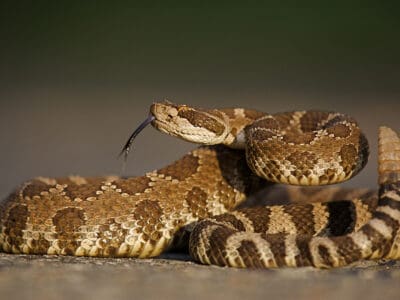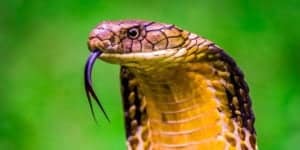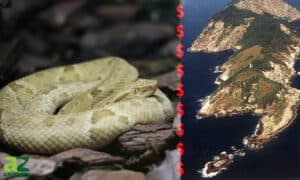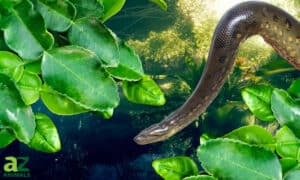Discover Maryland’s 4 Largest and Most Dangerous Snakes this Summer
Summertime means most people spend their time outdoors, either hitting the trails or driving to some of the best parks and campgrounds in Maryland. While doing so, it’s important to be aware of Maryland’s native snakes, including some venomous species, and how to avoid them.
In summer, most snakes are typically active early in the morning and late in the evening. They also come out at night when the temperatures are not so high. Searching for a mate, hunting, and basking bring many snakes out into the open in spring and summer more than in other seasons. So we’re most likely to encounter venomous and non-venomous snakes during this time.
Let’s look at Maryland’s 4 largest and most dangerous snakes this summer.
Maryland’s 4 Largest and Most Dangerous Snakes this Summer

Realest Nature/Shutterstock.com
Maryland is best known as “America in Miniature” because of its diverse panorama, ranging from the winding Atlantic Coast to the mountains. You can find just about any fundamental component of landscapes in this state, except a desert. This rich diversity also means that Maryland provides a habitat to many species of snakes.
As essential predators, snakes are an integral part of the fauna in this adorable state. Maryland is home to 27 species of snakes; two are venomous, the copperhead and the timber rattlesnake, both belonging to the viper family (Viperidae). The remaining species belong to the Colubridae family, the most prominent family of snakes in the world. Most colubrids are non-venomous, though their bites may cause adverse reactions in humans.
As you head out into the wild this summer, please keep an eye out for the following perfectly camouflaged snakes and learn the potential dangers. For your safety, treat all snake bites as if they were venomous and get medical treatment as quickly as possible.
1. Timber Rattlesnakes
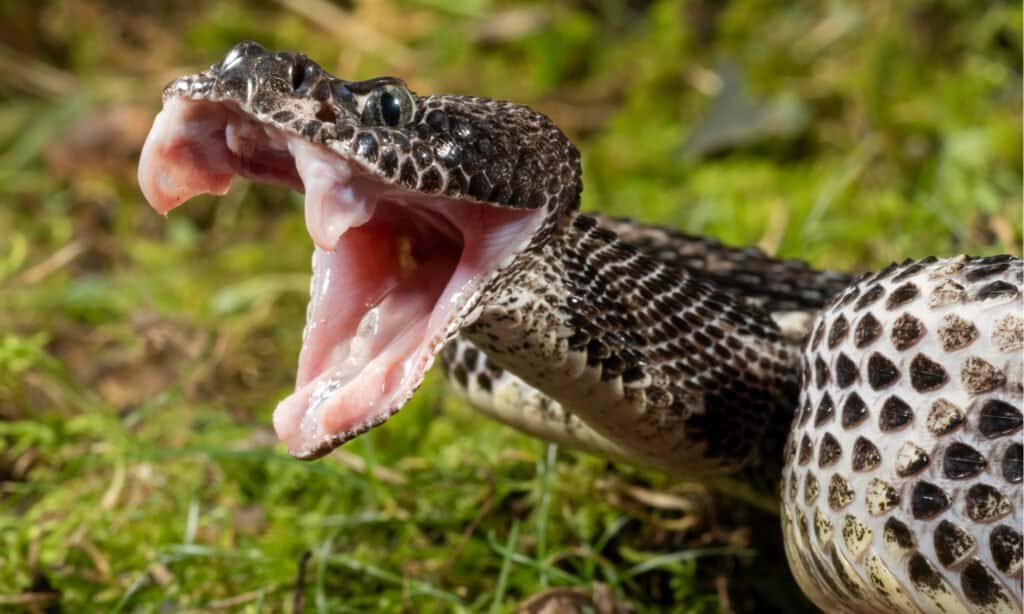
Joe McDonald/Shutterstock.com
The timber rattlesnake (Crotalus horridus) is one of the most venomous snakes in the world. It’s also commonly known as a banded rattlesnake or canebrake rattlesnake. This snake is endemic to eastern North America and is often sighted in Maryland- from Federick to Garret County.
The timber rattlesnake prefers to inhabit upland forested areas with talus slopes and rocky outcrops. Although highly venomous, it usually avoids areas frequented by humans. However, it readily bites when provoked and should be avoided by all means. It often performs a good deal of preliminary feinting and rattling before striking. This is probably enough time for you to flee.
The composition of a timber rattlesnake’s venom varies considerably between populations, some being hemorrhagic, while others being mainly neurotoxic (or a combination of both). Seek medical attention immediately if bitten.
Adults grow to a total length of 36-60 inches (3-5 feet) and weigh between 1.1 and 3.3 pounds. Large specimens weighing over five pounds and over 5 feet long have been reported.
Melanin is common in timber rattlesnakes, and some individuals may appear very dark, almost solid black. It has a pattern of light or dark brown crossbands on a grayish or yellowish-brown background. These crossbands have irregular zig-zag, “M,” or “V” -shaped edges.
2. Eastern Copperhead
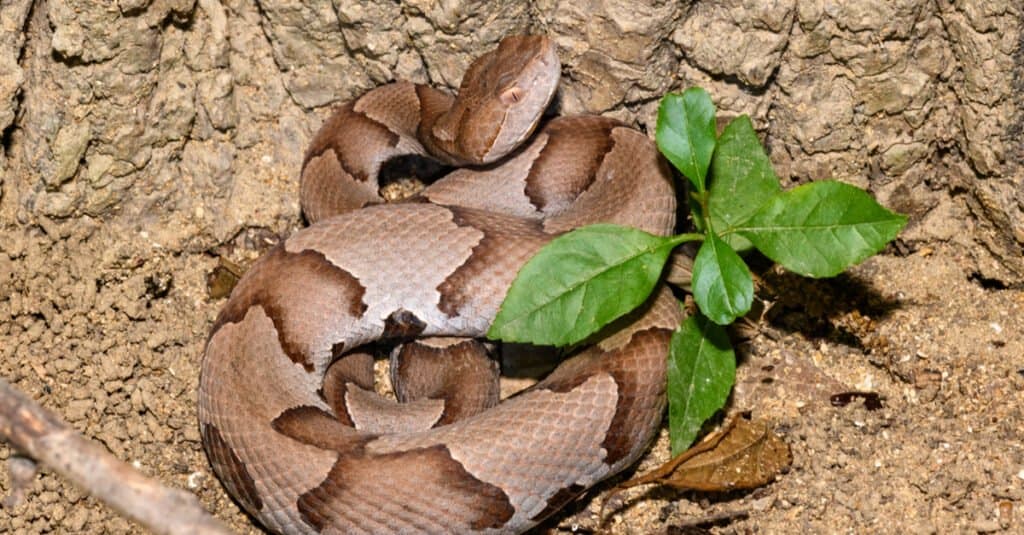
Jeff W. Jarrett/Shutterstock.com
Commonly known as the “copperhead,” the eastern copperhead (Agkistrodon contortrix) is a pit viper species native to eastern North America. It has a pale to pinkish-brown background with distinctive dark brown, hour-glass-shaped bands overlaid on the background color. Adults grow to a typical length of 2 to 3 feet. Some may exceed 3 feet, but it’s rare. It weighs between 0.25 and 0.75 pounds (4-12 ounces).
Eastern copperhead is a forest snake that prefers inhabiting deciduous forests and mixed woodlands. It may also occupy agricultural fields adjacent to forests and in swampy regions of central and western Maryland. This species does not seem particularly aggressive but will readily bite if provoked. It often employs a warning bite when agitated and injects a small amount of venom that can be very dangerous to humans.
Bite symptoms include extreme pain, throbbing, tingling, severe nausea, and swelling. The victim should seek immediate medical attention. It is always good to be very careful because a copperhead’s cryptic coloration makes it hard for one to discern it, even when you are looking right into this snake.
3. Eastern Ratsnake
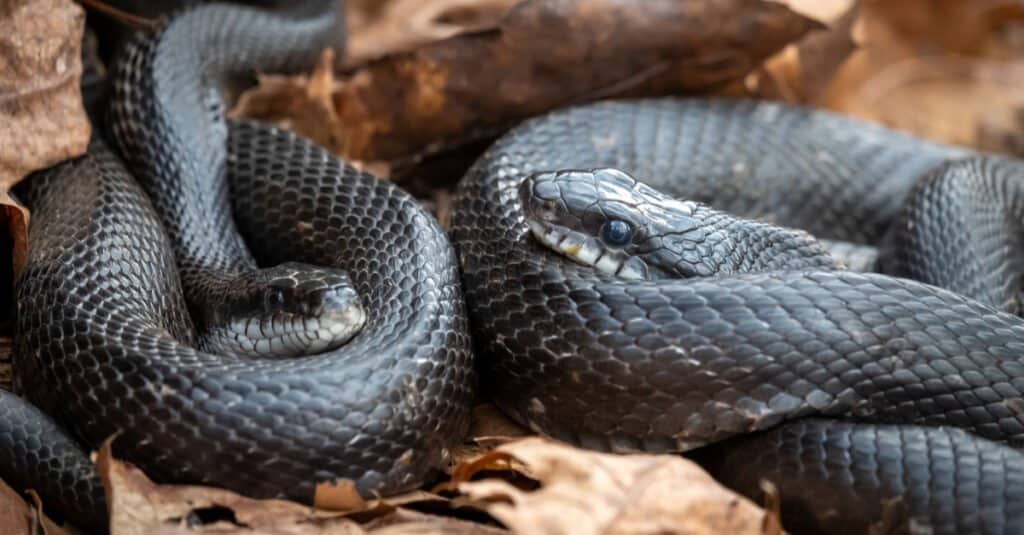
samray/Shutterstock.com
The eastern ratsnake (Pantherophis alleghaniensis)is a nonvenomous colubrid species found in Maryland. It is also known as the chicken snake, the pilot snake, the yellow rat snake, or the black rat snake. Although it’s nonvenomous, the eastern snake readily gives a painful bite when handled. Bites from this snake are also full of bacteria that can infect you.
An adult eastern snake measures 36 to 72 inches (3 to 6 feet) in total length, with some exceeding 79 inches (6.5 feet). The largest eastern ratsnake ever recorded was 13-feet 1-inch. It’s shiny black dorsally, with a white or cream throat and chin. It has an irregular black and white checkerboard pattern on its belly.
This snake lives in various habitats. It can be found all over the state in hardwood forests, isolated urban woodlots, forested wetlands, farmlands, and backyards. You might spot one crossing the roadways while driving on country roads just after sunset.
4. Common Garter Snake
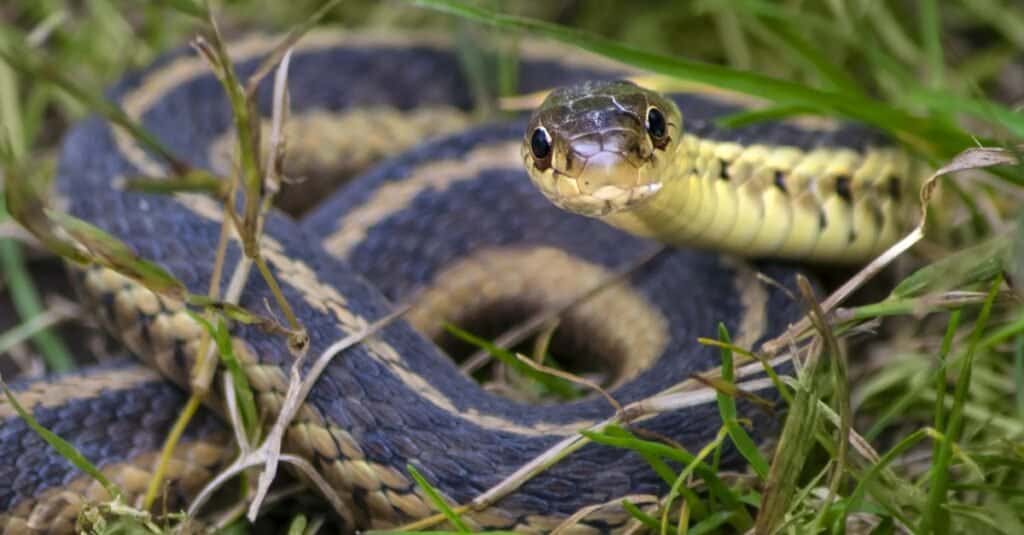
K Quinn Ferris/Shutterstock.com
The common garter snake (Thamnophis sirtalis) is a species of natricine snake that is found widely across Maryland. It inhabits riparian areas, old fields, meadows, freshwater marshes, forests, ditches, and backyards. You are more likely to encounter this common diurnal snake if you spend enough time outdoors this summer. Look specifically along the wetland edges.
It’s black, brown, olive, or greenish on the back with a distinct white or yellow stripe down the centerline. The area between these stripes is usually a checkerboard pattern of green and black spots. Its belly is cream to yellowish-green with dark spots on the edge of the belly scales.
The common garter snake is a thin species. Its average body mass is 0.33 pounds (5.3 oz). Its average length (including the tail) is 18-42 inches (1.5 to 3.5 feet). Few grow past 4 feet, and most of them stay smaller.
The common garter snake has a mild venom in its saliva, which can be toxic to some of its smaller prey, like rats and small birds. Its bite is not dangerous for humans, though one may experience slight pain, itching, swelling, and a few allergic reactions. It may also release a foul-smelling musk when handled.
Discover the “Monster” Snake 5X Bigger than an Anaconda
Every day A-Z Animals sends out some of the most incredible facts in the world from our free newsletter. Want to discover the 10 most beautiful snakes in the world, a “snake island” where you’re never more than 3 feet from danger, or a “monster” snake 5X larger than an anaconda? Then sign up right now and you’ll start receiving our daily newsletter absolutely free.
More from A-Z Animals
Summertime means most people spend their time outdoors, either hitting the trails or driving to some of the best parks and campgrounds in Maryland. While doing so, it’s important to be aware of Maryland’s native snakes, including some venomous species, and how to avoid them.
In summer, most snakes are typically active early in the morning and late in the evening. They also come out at night when the temperatures are not so high. Searching for a mate, hunting, and basking bring many snakes out into the open in spring and summer more than in other seasons. So we’re most likely to encounter venomous and non-venomous snakes during this time.
Let’s look at Maryland’s 4 largest and most dangerous snakes this summer.
Maryland’s 4 Largest and Most Dangerous Snakes this Summer

Realest Nature/Shutterstock.com
Maryland is best known as “America in Miniature” because of its diverse panorama, ranging from the winding Atlantic Coast to the mountains. You can find just about any fundamental component of landscapes in this state, except a desert. This rich diversity also means that Maryland provides a habitat to many species of snakes.
As essential predators, snakes are an integral part of the fauna in this adorable state. Maryland is home to 27 species of snakes; two are venomous, the copperhead and the timber rattlesnake, both belonging to the viper family (Viperidae). The remaining species belong to the Colubridae family, the most prominent family of snakes in the world. Most colubrids are non-venomous, though their bites may cause adverse reactions in humans.
As you head out into the wild this summer, please keep an eye out for the following perfectly camouflaged snakes and learn the potential dangers. For your safety, treat all snake bites as if they were venomous and get medical treatment as quickly as possible.
1. Timber Rattlesnakes

Joe McDonald/Shutterstock.com
The timber rattlesnake (Crotalus horridus) is one of the most venomous snakes in the world. It’s also commonly known as a banded rattlesnake or canebrake rattlesnake. This snake is endemic to eastern North America and is often sighted in Maryland- from Federick to Garret County.
The timber rattlesnake prefers to inhabit upland forested areas with talus slopes and rocky outcrops. Although highly venomous, it usually avoids areas frequented by humans. However, it readily bites when provoked and should be avoided by all means. It often performs a good deal of preliminary feinting and rattling before striking. This is probably enough time for you to flee.
The composition of a timber rattlesnake’s venom varies considerably between populations, some being hemorrhagic, while others being mainly neurotoxic (or a combination of both). Seek medical attention immediately if bitten.
Adults grow to a total length of 36-60 inches (3-5 feet) and weigh between 1.1 and 3.3 pounds. Large specimens weighing over five pounds and over 5 feet long have been reported.
Melanin is common in timber rattlesnakes, and some individuals may appear very dark, almost solid black. It has a pattern of light or dark brown crossbands on a grayish or yellowish-brown background. These crossbands have irregular zig-zag, “M,” or “V” -shaped edges.
2. Eastern Copperhead

Jeff W. Jarrett/Shutterstock.com
Commonly known as the “copperhead,” the eastern copperhead (Agkistrodon contortrix) is a pit viper species native to eastern North America. It has a pale to pinkish-brown background with distinctive dark brown, hour-glass-shaped bands overlaid on the background color. Adults grow to a typical length of 2 to 3 feet. Some may exceed 3 feet, but it’s rare. It weighs between 0.25 and 0.75 pounds (4-12 ounces).
Eastern copperhead is a forest snake that prefers inhabiting deciduous forests and mixed woodlands. It may also occupy agricultural fields adjacent to forests and in swampy regions of central and western Maryland. This species does not seem particularly aggressive but will readily bite if provoked. It often employs a warning bite when agitated and injects a small amount of venom that can be very dangerous to humans.
Bite symptoms include extreme pain, throbbing, tingling, severe nausea, and swelling. The victim should seek immediate medical attention. It is always good to be very careful because a copperhead’s cryptic coloration makes it hard for one to discern it, even when you are looking right into this snake.
3. Eastern Ratsnake

samray/Shutterstock.com
The eastern ratsnake (Pantherophis alleghaniensis)is a nonvenomous colubrid species found in Maryland. It is also known as the chicken snake, the pilot snake, the yellow rat snake, or the black rat snake. Although it’s nonvenomous, the eastern snake readily gives a painful bite when handled. Bites from this snake are also full of bacteria that can infect you.
An adult eastern snake measures 36 to 72 inches (3 to 6 feet) in total length, with some exceeding 79 inches (6.5 feet). The largest eastern ratsnake ever recorded was 13-feet 1-inch. It’s shiny black dorsally, with a white or cream throat and chin. It has an irregular black and white checkerboard pattern on its belly.
This snake lives in various habitats. It can be found all over the state in hardwood forests, isolated urban woodlots, forested wetlands, farmlands, and backyards. You might spot one crossing the roadways while driving on country roads just after sunset.
4. Common Garter Snake

K Quinn Ferris/Shutterstock.com
The common garter snake (Thamnophis sirtalis) is a species of natricine snake that is found widely across Maryland. It inhabits riparian areas, old fields, meadows, freshwater marshes, forests, ditches, and backyards. You are more likely to encounter this common diurnal snake if you spend enough time outdoors this summer. Look specifically along the wetland edges.
It’s black, brown, olive, or greenish on the back with a distinct white or yellow stripe down the centerline. The area between these stripes is usually a checkerboard pattern of green and black spots. Its belly is cream to yellowish-green with dark spots on the edge of the belly scales.
The common garter snake is a thin species. Its average body mass is 0.33 pounds (5.3 oz). Its average length (including the tail) is 18-42 inches (1.5 to 3.5 feet). Few grow past 4 feet, and most of them stay smaller.
The common garter snake has a mild venom in its saliva, which can be toxic to some of its smaller prey, like rats and small birds. Its bite is not dangerous for humans, though one may experience slight pain, itching, swelling, and a few allergic reactions. It may also release a foul-smelling musk when handled.
Discover the “Monster” Snake 5X Bigger than an Anaconda
Every day A-Z Animals sends out some of the most incredible facts in the world from our free newsletter. Want to discover the 10 most beautiful snakes in the world, a “snake island” where you’re never more than 3 feet from danger, or a “monster” snake 5X larger than an anaconda? Then sign up right now and you’ll start receiving our daily newsletter absolutely free.

